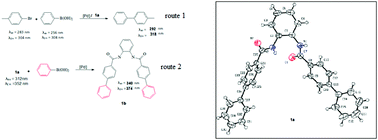Study of the dual functional behaviour of 1,2-bis(4-bromobenzamide)benzene by synchronous fluorescence spectroscopy†
Abstract
This study presents the dual functionality of 1,2-bis(4-bromobenzamide)benzene, where depending on the stoichiometric conditions, temperature and reaction time, the compound may act as a PdCl2 ligand or as one of the reactants of the Suzuki coupling reaction. This dual functional behaviour was confirmed in the catalytic reactions which were monitored using synchronous fluorescence spectroscopy. Based on the results, the reaction is a versatile system, since the bisamide can act at different stages of the coupling mechanism, and supports the principle of green chemistry as mild reaction conditions and non-toxic solvents were used.



 Please wait while we load your content...
Please wait while we load your content...